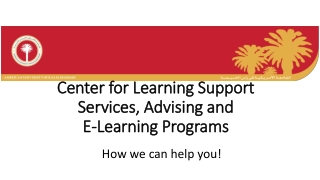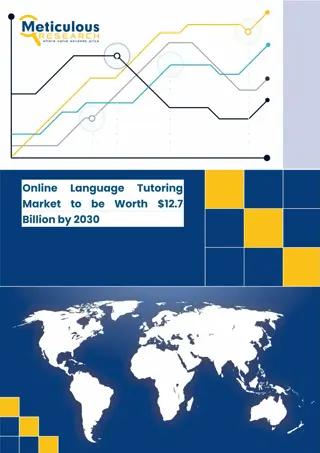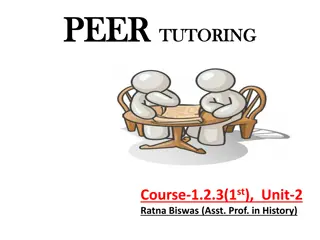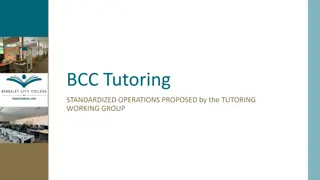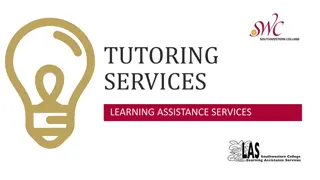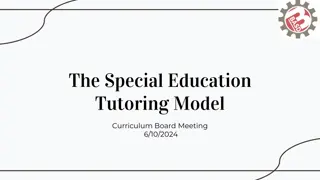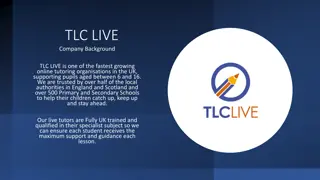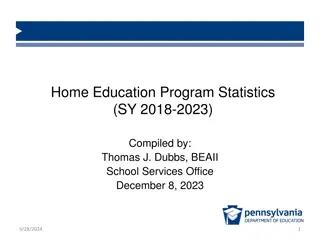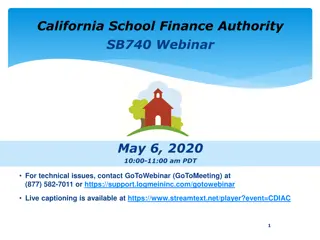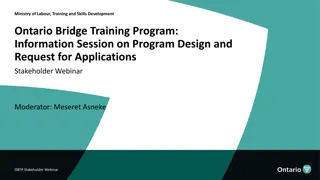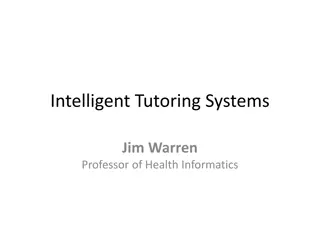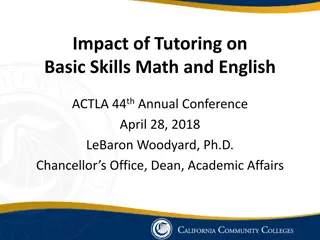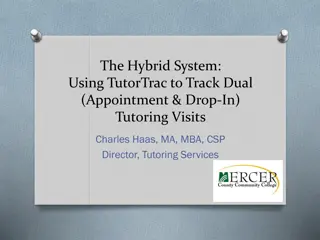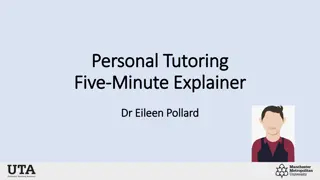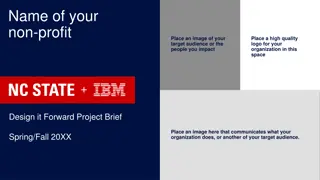
High Impact Tutoring Program Design Overview
Explore the key principles of high impact tutoring programs, emphasizing the importance of well-trained tutors, quality instructional material, individualized support, and data-driven sessions. Learn how high impact tutoring can significantly enhance student outcomes and discover resources like the Accelerator for effective implementation.
Download Presentation

Please find below an Image/Link to download the presentation.
The content on the website is provided AS IS for your information and personal use only. It may not be sold, licensed, or shared on other websites without obtaining consent from the author. If you encounter any issues during the download, it is possible that the publisher has removed the file from their server.
You are allowed to download the files provided on this website for personal or commercial use, subject to the condition that they are used lawfully. All files are the property of their respective owners.
The content on the website is provided AS IS for your information and personal use only. It may not be sold, licensed, or shared on other websites without obtaining consent from the author.
E N D
Presentation Transcript
High Impact Tutoring: Program Design As you join us, please: Introduce yourself via chat with your name, LEA/Organization, and your favorite breakfast food.
Introduction: TEA Team A few logistical notes: Feel free to enter questions and reactions in the chat box throughout We will follow up with the slides and recording Megha Kansra Director of System Support & Innovation Lizette Ridgeway Director of District Systems and Strategies Mercedes Aquilini Ed Direction Megha.Kansra @tea.texas.gov Lizette.Ridgeway @tea.texas.gov Mercedes.Aquilini @tea.texas.gov 2
Agenda for Today Quick Recap of Webinar #1 LEA Spotlight: Ector County ISD High Impact Tutoring Toolkit: Program Design Implementation Workshop Series Overview Closing and Questions 3
Recap of Webinar #1 The Accelerator provides comprehensive resources for those interested in implementing high-impact tutoring. Designed with the needs of tutoring organizations, schools and districts in mind, the Accelerator tools articulate best practices, drawing on an extensive body of existing research. 4
Key Principles of High Impact Tutoring High impact tutoring programs have a few key attributes1 and can have a significant impact on student outcomes Well-trained, consistent tutor (can be a teacher, paraprofessional, teacher candidate) who builds a strong relationship with students A 2020 meta-analysis of 96 studies of high-quality tutoring programs found that students made 5 months of additional progress on average, a large pooled 0.37 effect size3 5 months High quality instructional material aligned to standards and core classwork Additional progress One-to-one or small group for individualized support (1-to-3 maximum ratio recommended)2 Embedded in the school day or immediately before or after, to maximize student access The recording of the first webinar can be found on the Strong Start page At least three sessions per week for sustained support, 30 minutes minimum Data-driven with tutors building sessions around student strengths and needs Sources: 1) Kraft, Matthew A., and Grace Falken. (2021). A Blueprint for Scaling Tutoring Across Public Schools. (EdWorkingPaper: 21-335). Annenberg Institute at Brown University: https://doi.org/10.26300/dkjh-s987; 2) Researchers are still vetting the effectiveness of 1:4 groups and currently recommend a careful approach to 1:4 support, with Dr. Robert Slavin (Johns Hopkins University) recommending: I would keep careful track of how students are progressing A lot of kids will be successful at one-to-four [groups] but there may be kids who are not, and I would reserve one-to-one for those who are not (Source: Education Week) 3) Nickow, Andre Joshua, Philip Oreopoulos, and Vincent Quan. (2020). The Impressive Effects of Tutoring on PreK-12 Learning: A Systematic Review and Meta-Analysis of the Experimental Evidence. (EdWorkingPaper: 20-267). Annenberg Institute at Brown University: https://doi.org/10.26300/eh0c-pc52; 4) Kraft, M. A. (2020). Interpreting effect sizes of education interventions. Educational Researcher, 49(4), 241-253. 5
Overview of Ector County ISD Tutoring Model: Outcomes-Based Contracting 7
Overview of Ector County ISD Tutoring Model: Outcomes-Based Contracting Pilot Program Organized transition into tutoring session immediately after school Professional Virtual Tutors Tutors use District s Measure of Academic Progress (MAP) data coupled with their curriculum Personalized and data-informed support for student success One-on-one tutoring: 19 hours/student for 60 students Outcomes-Based Contract $25/hour Example Scenarios per student 50% growth percentile: $1,000 base pay 52% growth percentile: $1,050 55% growth percentile: $1,100 8
Overview of Ector County ISD Tutoring Model: Outcomes-Based Contracting Future Considerations Flexibility with embedded tutoring sessions Professional virtual tutors trained and vetted by provider Tutors use District s curriculum and MAP data Personalized and data-informed support for student success One-on-One tutoring: 60 hours/student/year Outcomes-Based Contracting 9
Overview of Ector County ISD Tutoring Model: Outcomes-Based Contracting PRIORITIZING STUDENTS PROGRAM FOCUS MAP, STAAR/EOC, & SCA triangulation Economically Disadvantaged PreK-2 in ELAR and Math 7-8th in ELAR and Math English Learners English I Special Education Algebra I 10
Overview of Ector County ISD Tutoring Model: Outcomes-Based Contracting SELECTING PROVIDER DELIVERY MODE RFP established terms for consortium members Synchronous instruction State bid List Virtual and in-person Specific services targeted to needs Audio and/or video engagement Service capacity Collaboration with teacher 11
Overview of Ector County ISD Tutoring Model: Outcomes-Based Contracting SCHEDULE TEAM ASSEMBLY District Level: Collaborative schedule design for optimal student engagement Create RFPs, select providers, establish data sharing agreements, conduct program evaluation Campus Level: Select students, create schedules for tutoring, collaborate with providers Uninterrupted block of time Teachers: Discuss student needs and curriculum with tutors Tutoring Providers: Customized to fit campus needs Submit RFP proposals, collaborate with district and campus personnel, monitor student growth 12
Overview of Ector County ISD Tutoring Model: Outcomes-Based Contracting SUCCESSES OPPORTUNITIES Professional tutors well versed in interpreting data and supporting areas of need Positive response to one-on-one tutoring Personalized learning based on individual student needs Not a one-size fits all structure Finding a provider that has capacity to meet need Outcomes-based contract design 13
Discussion Questions Reflecting on the past year, what have been your key successes, and what challenges have you encountered? What are your current plans for expanding your tutoring program? 14
Introduction to High Impact Tutoring Toolkit The High Impact Tutoring Toolkit outlines the foundational principles and key considerations that all LEAs should consider when implementing a high impact tutoring program. Table of Contents Background and Research Key Principles of High Impact Tutoring Program Design Assembling The Team Selecting A Program Focus Student Prioritization Creating the Structure Scheduling Dosage Delivery Mode Selecting a Tutoring Provider Identifying High-Quality Instructional Materials Program Implementation Training Tutors and Providing Ongoing Support Curriculum and Instructional Strategy Engaging Stakeholders Evaluating the Program Ensuring Equity 16
Assembling the Team Team Role Key Responsibilities Time Commitment Assists in setting vision and strategy; ensures tutoring initiative is sufficiently resourced Senior Project Sponsor Low Sets the vision and strategy; project manages the program internally Tutoring Program Lead High Ensures strong implementation of tutoring program at the campus School Site Managers Medium Oversees tutor training; provides feedback from tutors to central team Tutor Coaches Medium Ensures all tutors have access to high quality instructional materials Curriculum & Instruction Lead Low Ensures all students are equipped with necessary devices, programs, and connectivity Technology Lead Low Develops a performance measurement plan for the program; supports with data reporting Data Lead Low Ensures strong implementation of tutoring program among diverse learners Diverse Learner Lead Low Coordinates with tutors as needed to ensure alignment of key content with tutoring sessions Teacher Advisory Group Low Low 2-3 hours a month High 20+ hours a week Med 5 hours a week 17
Selecting A Program Focus When selecting a program focus, LEAs should consider three main factors: Student Needs Review student assessment data to identify key gaps in student learning Disaggregate data by content area, grade level, and student population Tutoring Effect The research evidence is strongest for tutoring focused on early literacy and middle-school math Cost 60-80% of tutoring costs are related to personnel. Teacher-led tutoring is most expensive (~$3,600 per pupil) whereas tutoring by trained volunteers is free (although LEAs may need to invest in training and other supports) 18
Student Prioritization There are three key models for determining which students to prioritize. These decisions will affect various aspects of the tutoring program, but each model can lead to positive effects. Need Driven Curriculum Driven Universal Tutoring is targeted to students who are struggling and perform below particular benchmark thresholds. Tutoring is provided at critical moments when students generally tend to fall behind. Definition All students receive tutoring. Reading Recovery is a short- term invention in reading and writing that focuses specifically on first grade as it is a crucial point for literacy development. Pharr-San Juan-Alamo ISD identified a group of priority- for-service migrant students based on failure rates and other academic indicators. In 2005, MATCH Charter Public High School integrated two hours of individualized tutorials throughout an extended school day. Example 19
Creating the Structure - Scheduling There are several different ways that districts have been able to integrate tutoring into their school day: Elementary Sample Schedule from Spring ISD Lunch/Recess/CAMP/Intervention Schedule Intervention Periods Intervention periods are a highly effective way to build tutoring into the school day, as it ensures that all students can participate and creates significantly higher likelihood of student attendance. Before or After School If tutoring occurs immediately before or after the school day, structures should be put in place to ensure that students are directed to the tutoring location. In-Class Tutoring In this model, students receiving tutoring are pulled out of other classes to participate in tutoring. Tutoring sessions should be scheduled to avoid conflicts with the respective subject of tutoring. Computer Art Music Physical Education 20
Creating the Structure Delivery Mode Both virtual and in-person tutoring can be effective if they follow the key principles of high impact tutoring. In-person Virtual Strengths Increases likelihood of participation Encourages relationship-building between tutor and student Strengths Expands the pool of tutors Reduces transition time and logistical obstacles Challenges Shrinks the pool of tutors Requires detailed planning to overcome any logistical obstacles Challenges Requires additional resources to establish and maintain the technological infrastructure Has a greater risk of decreased participation and attendance 21
Selecting A Tutoring Provider Key considerations for determining who will provide the tutoring services: Recruiting Own Tutors Working with a Tutoring Provider Tutoring organizations often bring additional capabilities beyond recruiting and managing tutors, including data analytics and program evaluation systems The LEA has full control over the tutor type (teachers, volunteers, college students, etc.) and required qualifications Tutor training is customized to the school curriculum and culture For LEAs considering virtual tutoring, many tutoring organizations have created their own virtual platforms with unique capabilities designed for tutoring Recruiting and managing tutors requires a significant share of resources for LEAs. LEAs that choose this option will likely require at least one full-time program director, with help from additional staff members Many tutoring organizations have their own curriculum and have already trained their tutors in effectively delivering that curriculum. TEA is currently working on developing a vetted list of tutoring providers for LEAs to leverage more info to come 22
Identifying High-Quality Instructional Materials High-Quality Instructional Materials (HQIM) are the foundational tools for tutors to lead successful instruction. Key Considerations: Aligned to core classroom content Helps student to access grade-level content Content specific research-backed approaches Texas Home Learning (THL) includes access to high-quality, TEKS-aligned core instructional materials and supplemental instructional materials. Examples include: Eureka Math TEKS Edition ST Math Carnegie Learning Texas Math Solution Amplify Texas Elementary Literacy Program Early Literacy: Foundational skills ELAR: Background knowledge and vocabulary Math: Deepen conceptual understanding and use of strategies Science: Background knowledge Tutor facing lesson plans and guidance Daily activities, objectives, suggested strategies Presence of formative assessment tools and progress monitoring Quantitative and qualitative 23
24 TEA Supports
High Impact Tutoring Implementation Workshop Series Overview The High Impact Tutoring Implementation Workshop Series is intended to provide training and coaching to districts to help them establish high-impact tutoring programs through a 3-4 week, intensive workshop. Program Application Process and Timeline Date(s) Event May 27 Release: TAA and application are live June 7 Applications Due: LEAs required to have submitted application (Google Form) by 5 pm CT June 11 Application Status Notification: Accepted and waitlisted LEAs notified of status Commitment Forms: Accepted LEAs commitment forms due (agreement to complete workshop series, attend synchronous sessions on scheduled dates, and commit to key actions recommended for successful implementation) Workshop Series Cycle 1: First cohort of up to 30 LEAs completes Workshop Series Cycle 1, including 4-8 synchronous workshop sessions, office hours, and asynchronous supports Workshop Series Cycle 2+: Additional cycles of workshop series support to be offered, depending on continued demand and LEA interest June 15 June 21 July 16 Mid-July onward 25
Were Here To Help! Please contact us with any questions! We have a dedicated communication stream to empower and enable success around high-impact tutoring work. Email: TexasTutoring@tea.texas.gov 27

